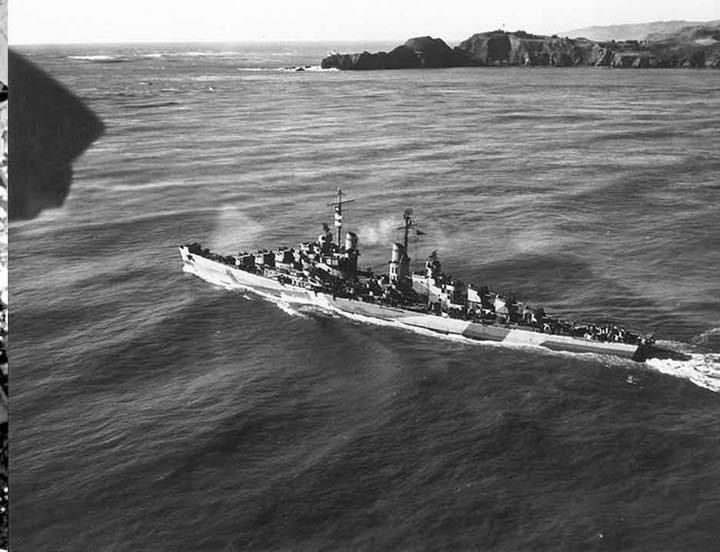USS Reno CL-96

Walter E. Reno was born in Davis County, Iowa, in 1881, joined the Navy and rose to the rank of lieutenant commander, prior to his death 19 November 1917. In command of Chauncey (DD-3) at that time, he died when his ship was sunk after colliding with the British merchantman Rose off Gibraltar.
The first Reno (DD-303) was named in honor of Walter E. Reno; the second (CL-96) for the city in Nevada.
II
(CL - 96: displacement 8,600 (full load) ; length 5410; beam 532; draft 266; speed 31 knots; complement 688; armament 12 5, 16 40mm., 16 20mm., 8 21 torpedo tubes, 2 depth charge tracks; class Atlanta)
The second Reno (CL-96) was laid down by Bethlehem Steel Co., San Francisco, Calif., 1 August 1941; launched 23 December 1942; sponsored by Mrs. August C. Frohlich; and commissioned 28 December 1943, Capt. Ralph C. Alexander in command.
Following shakedown off San Diego, Reno departed San Francisco, 14 April 1944, to join the 5th Fleet. As an active unit in Vice Adm. Marc A. Mitscher's Task Force 58, she first came in contact with the enemy by supporting air strikes against Marcus Island on 19-20 May. Three days later, she also supported strikes on Wake Island.
During the months of June and July, Reno joined the fast carriers in surprise attacks against Saipan, 11 June, Pagan Island, 12-13 June, and against the Volcano and Bonin Islands - Iwo Jima, Haha Jima, and Chichi Jima - -on 15-16 June. Three days later, she assisted in repelling a large-scale Japanese carrier force attempt to defeat the Allied invasion of Saipan in the Battle of the Philippine Sea.
From 20 June to 8 July, Reno joined in the operations covering the capture of Saipan, then covered landings on Guam from 17-24 July and 2 days later, took part in the strikes against the Palau Islands from the 26th to the 29th. Swinging north again, a final strike was made on the Bonin Islands 4-5 August and on 7 September the task group returned to the Palaus.
Continuing west, Reno participated in raids against Mindanao and adjacent Philippine Islands 9-13 September, supported the Palau invasion 15-20 September, and on the 21st and 22d, supported strikes against Manila and vicinity. Striking Nansei Shoto on 8 October, Reno, with TF 38 came nearer to the home islands of Japan than any other major unit of the U. S. Fleet had been.
During the 3-day strike on Formosa 12-14 October, Reno shot down six enemy planes. At the height of the battle, one torpedo plane crashed and exploded on the Renos main deck aft. Though Turret Six was partially incapacitated by the explosion, the turret captain succeeded in maintaining his fire against the attacking planes and ships.
On 24 October, 4 days after the initial Leyte invasion, while supporting air strikes against the Luzon area, TF 38 was subjected to a large-scale air attack by land planes from Clark Field. The light carrier Princeton (CVL-23) was struck and forced to withdraw from the task group. Reno, assigned to help fight her fires and rescue personnel, came alongside five times but could not remain because of the intense heat and smoke. While Reno evacuated wounded men and tried to bring the fires under control, the listing flight deck of Princeton crushed one of Renos 40mm mounts. Efforts to save the carrier continued; but, after Princetons torpedo warhead stowage area exploded, Reno was ordered to sink her. On 25 October, having rejoined the task force, Reno proceeded north to engage the northern Japanese task force closing for the Battle of Cape Engao - the last engagement in the Battle for Leyte Gulf.
On the night of 3 November, well off San Bernardino Strait, Reno was torpedoed in the port side by Japanese submarine I-41. Towed 1,500 miles to Ulithi for temporary repairs, she then steamed under her own power to Charleston where she entered the Navy Yard 22 March for repairs. Emerging 7 months later, she steamed to Texas, then back to Charleston for the addition of bunk spaces. She reported for "Magic-Carpet" duty and made two runs to Le Havre, France, and back with Army troops.
In early 1946, Reno steamed for Port Angeles, Wash., where she decommissioned, 4 November 1946 and entered the Pacific Reserve Fleet, berthed at Bremerton. Reclassified CLAA-96, 18 March 1949, she remained at Bremerton until her name was struck from the Navy list 1 March 1959 and her hulk was sold, 22 March 1962, to Coal Export Co., New York.
Reno earned three battle stars for World War II service.
 >
>